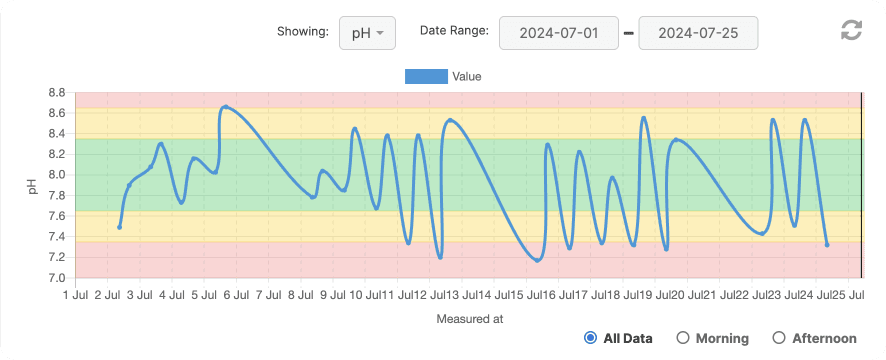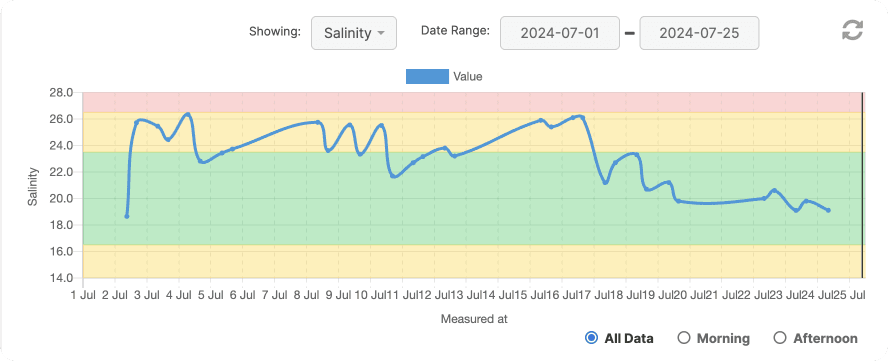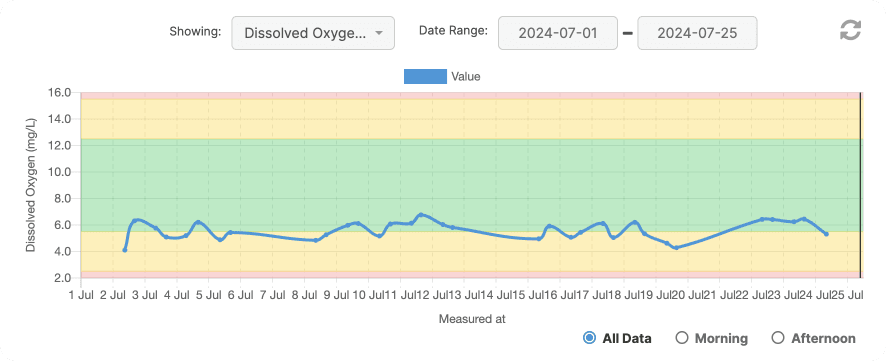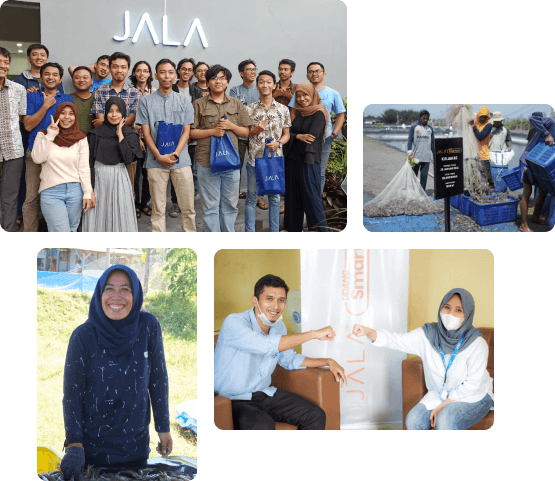
The water quality of vannamei shrimp ponds is composed of all the physical, chemical, and biological characteristics that make the pond water usable. A shrimp farm is an aquatic ecosystem where each characteristic is interdependent and interconnected.
Well-maintained water quality in the farm ensures healthy and high quality shrimp, more efficient production, and minimal impact to the environment. Ideal water quality is not just about specific numbers but maintaining stability over time. How to manage shrimp pond water quality properly? Find the answers in this article.
Factors that Affect Water Quality
1. Shrimp pond input
The demand for optimal production can cause pond water quality to decrease. This is due to the amount of input or load in the cultivation pond, which consists of synthetic or organic fertilizers, feed, probiotics, and other materials that can lead to blooming algae and disrupt the water quality. Blooming algae, in turn, causes DO to decrease and the production of toxins from several types of phytoplanktons.
2. Fry stocking density
The stocking density of shrimp fry needs to be adjusted according to the pond volume. The higher the stocking density, the more challenging it will be to manage water quality. An overly high density can reduce DO levels, threatening shrimp health. Controlling the stocking density ensures that there is adequate space for shrimp to move and grow, minimizing disease risks and reducing FCR.
3. Weather conditions
Weather is an external factor that also affects pond water quality. Hot weather causes the temperature to rise, leading to water evaporation which increases salinity. On the other hand, rain decreases the temperature, pH, and salinity. As weather conditions cannot be controlled, farmers need to monitor changes in water quality due to weather and take necessary steps for adjustment.
The Effects of Poor Water Quality on Vannamei Shrimp
Poor water quality in shrimp ponds can negatively affect shrimp health and growth. As water quality decreases, shrimp become more susceptible to various diseases, leading to higher mortality rates and reduced productivity. Poor water conditions can also slow shrimp growth, decreasing profits for farmers. Therefore, effective water quality management is crucial for ensuring a productive cultivation.
The Importance of Measuring Shrimp Farm Water Quality
Measuring shrimp farm water quality parameters is one part of water quality management and serves as a basis for decision making. Analysis and interpretation of the obtained water quality data is essential for an efficient and smooth cultivation.
Water quality parameters are monitored everyday to anticipate issues in the cultivated shrimp. Some important variables to monitor are temperature, pH, DO, salinity, and ORP. Additionally, chemical parameters like alkalinity, organic matter, ammonia, nitrite, nitrate, and microbiological parameters such as total bacteria and plankton should also be monitored.
Measurements are regularly taken at specific times, such as early morning (5:00-6:00 AM) and around noon (12:00-2:00 PM). The early morning period is when DO and pH are the lowest, with the highest carbon dioxide content. The peak of phytoplankton photosynthesis happens around noon, resulting in the highest DO and pH levels. Other important measurement times are in the evening (4:00-5:00 PM) and at night (8:00-10:00 PM). Use water quality measurement device such as JALA Baruno for accurate readings.
Case Study on Water Quality Management
In the following case study, a farmer named Mr Jali found that the shrimp growth recorded on JALA App falls below the target and estimation.

Mr Jali then conducts water quality measurements to check whether some parameters are hindering his shrimp’s growth.

The pH graph shows quite drastic fluctuations over several weeks. Often, the pH is either below or above the ideal range. A pH value that is too low can cause shrimp to lose their appetite, eat less, and grow more slowly. On the other hand, when the pH is too high, toxic compounds from BGA and ammonia can increase. pH can be stabilized by changing the water if it is too high or by adding lime if it is too low.

The salinity is also unstable, as there are some days where it increases drastically and drops again. This can be due to weather conditions, for example, salinity may increase during periods of hot weather, causing stress to shrimp. To decrease salinity, Mr Jali can add freshwater to his pond.

Checking his pond's DO graph, DO should be kept constantly above 4 ppm as this is more ideal for shrimp, such as by adding paddle wheels or aeration in his pond.
Based on the recorded data, Mr. Jali can make the necessary adjustments to improve his shrimp's ADG, especially for pH and salinity parameters.
Conclusion
Vannamei shrimp farm water quality is affected by various factors such as inputs in the cultivation pond, fry stocking density, and weather conditions. Regular measurement of water quality parameters is a crucial part of water quality management and serves as a basis for decision making in order to maintain pond water as an ideal environment for shrimp to grow.
To keep the records of water quality data measured with JALA Baruno and monitor various other cultivation parameters, farmers can use JALA App. JALA App is #HeretoHelp farmers record, monitor, and analyze cultivation conditions and make better decisions for their shrimp farm. Register now at app.jala.tech and download the mobile version from Google Play Store or App Store!
Resources:
- Boyd, C. E., and C. S. Tucker. 1998. Pond Aquaculture Water Quality Management. Springer Science+Business Media. New York.
- Supono. 2017. Teknologi Produksi Udang. Plantaxia. Yogyakarta





